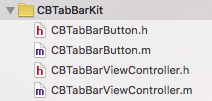iOS自定义Tabbar
因为公司需求,苹果的原生tabBar已经不能满足本人类的需求,我在网上查了下,觉得还是自己写一个tabBar比较好。
虽然是自定义tabBar,还是在原生基础上写
基本思路就是:隐藏系统原生tabBar,自己写一个tabView(一个自定义View)放在底部当成tabBar,在点击View上面的button的时候调用原生方法,实现控制器切换
可以实现的功能:
1 可以自己随意的隐藏显示tabBar,实现一些关于tabBar的动画,所有的一切只需要设置tabView就可以了
2 可以自定义tabBar的样式,在tabBar上添加背景图,添加气泡等等完全无压力
在网上找了一个别人写好的tabBar,然后自己修改了一下,立即就可以实现需求,非常方便
CBTabBar
只有两个类

CBTabBarViewController的.h代码
#import <UIKit/UIKit.h> /* *可以实现隐藏tabBar功能 */ @interface CBTabBarViewController : UITabBarController -(void)hidCBTabbar:(BOOL)ishid; @property (nonatomic, strong) NSArray * imageNameArray; @property (nonatomic, strong) NSArray * imageName_sel_Array; -(instancetype)initWithImageArray:(NSArray *)array andImageSelArray:(NSArray *)selArray; -(void)setSelectedButton:(NSUInteger)selectedIndex; @end
CBTabBarViewController的.m代码
#import "CBTabBarViewController.h"
#import "CBTabBarButton.h"
@interface CBTabBarViewController (){
UIView * myView;
NSMutableArray * _buttonArray;
}
@property (nonatomic, weak) UIButton *selectedBtn;
@end
@implementation CBTabBarViewController
-(instancetype)initWithImageArray:(NSArray *)array andImageSelArray:(NSArray *)selArray{
self = [super init];
if (self) {
self.imageNameArray = array;
self.imageName_sel_Array = selArray;
[self loadSubView];//添加自定义tabBar
}
return self;
}
- (void)viewDidLoad {
[super viewDidLoad];
self.imageNameArray = [NSArray array];
self.imageName_sel_Array = [NSArray array];
_buttonArray = [[NSMutableArray alloc] init];
}
-(void)loadSubView{
//删除现有的tabBar
CGRect rect = self.tabBar.frame;
[self.tabBar removeFromSuperview]; //移除TabBarController自带的下部的条
//添加自己的视图
/*
*tabBar的底部View
*背景图,button都会添加到这个myVIew上面
*可以自己添加其他View
*/
myView = [[UIView alloc] init];
myView.frame = rect;
// myView.backgroundColor = [UIColor redColor];
[self.view addSubview:myView];
//给tabBar添加自定义背景图
UIImageView * imageView = [[UIImageView alloc] init];
imageView.image = [UIImage imageNamed:@"tabBarBGImg"];
imageView.frame = CGRectMake(0, 0, myView.frame.size.width, myView.frame.size.height);
[myView addSubview:imageView];
if (self.imageName_sel_Array.count < 1 || self.imageNameArray.count < 1) {
return;
}
[_buttonArray removeAllObjects];
for (int i = 0; i < 5; i++) {
CGFloat x = i * myView.frame.size.width / 5;
UIView * view = [[UIView alloc] initWithFrame:CGRectMake(x, 2, myView.frame.size.width / 5, myView.frame.size.height)];
[myView addSubview:view];
if (i == 2) {
view.frame = CGRectMake(x, 0, myView.frame.size.width / 5, myView.frame.size.height);
}
//tabber 上面的button
CBTabBarButton *btn = [[CBTabBarButton alloc] init];
NSString *imageName = [self.imageNameArray objectAtIndex:i];
NSString *imageNameSel = [self.imageName_sel_Array objectAtIndex:i];
[btn setImage:[UIImage imageNamed:imageName] forState:UIControlStateNormal];
[btn setImage:[UIImage imageNamed:imageNameSel] forState:UIControlStateSelected];
btn.tag = i;//设置按钮的标记, 方便来索引当前的按钮,并跳转到相应的视图
[btn addTarget:self action:@selector(clickBtn:) forControlEvents:UIControlEventTouchUpInside];
btn.center = CGPointMake(view.frame.size.width / 2, view.frame.size.height / 2);
btn.bounds = CGRectMake(0, 0, 40, 40);
[view addSubview:btn];
[_buttonArray addObject:btn];
//设置刚进入时,第一个按钮为选中状态
if (0 == i) {
btn.selected = YES;
self.selectedBtn = btn; //设置该按钮为选中的按钮
}
}
}
//通过点击tabBar上面的button来跳转控制器
- (void)clickBtn:(UIButton *)button {
//1.先将之前选中的按钮设置为未选中
self.selectedBtn.selected = NO;
//2.再将当前按钮设置为选中
button.selected = YES;
//3.最后把当前按钮赋值为之前选中的按钮
self.selectedBtn = button;
//4.跳转到相应的视图控制器. (通过selectIndex参数来设置选中了那个控制器)
self.selectedIndex = button.tag;
}
//调用此方法来跳转控制器
-(void)setSelectedButton:(NSUInteger)selectedIndex{
//1.先将之前选中的按钮设置为未选中
self.selectedBtn.selected = NO;
//2.从buttonarray中找到当前button
UIButton * button = [_buttonArray objectAtIndex:selectedIndex];
//3.最后把当前按钮赋值为之前选中的按钮
button.selected = YES;
//4.跳转到相应的视图控制器. (通过selectIndex参数来设置选中了那个控制器)
self.selectedIndex = selectedIndex;
}
//通过设置View的透明度来隐藏tabBar
-(void)hidCBTabbar:(BOOL)ishid{
if (ishid) {
myView.alpha = 0;
}else{
myView.alpha = 1;
}
}
CBTabBarButton.m代码
-(void)setHighlighted:(BOOL)highlighted{
//只需要取消高亮,这里什么都不用写
}
调用tabBar的代码
#import "ViewController.h"
#import "CBTabBarViewController.h"
#import "TestViewController.h"
@interface ViewController ()
@end
@implementation ViewController
- (void)viewDidLoad {
[super viewDidLoad];
UIViewController *firstViewController = [[TestViewController alloc] init];
firstViewController.view.backgroundColor = [UIColor redColor];
UIViewController *firstNavigationController = [[UINavigationController alloc]
initWithRootViewController:firstViewController];
UIViewController *secondViewController = [[TestViewController alloc] init];
secondViewController.view.backgroundColor = [UIColor yellowColor];
UIViewController *secondNavigationController = [[UINavigationController alloc]
initWithRootViewController:secondViewController];
UIViewController *thirdViewController = [[TestViewController alloc] init];
thirdViewController.view.backgroundColor = [UIColor greenColor];
UIViewController *thirdNavigationController = [[UINavigationController alloc]
initWithRootViewController:thirdViewController];
UIViewController *fourthViewController = [[TestViewController alloc] init];
fourthViewController.view.backgroundColor = [UIColor orangeColor];
UIViewController *fourthNavigationController = [[UINavigationController alloc]
initWithRootViewController:fourthViewController];
UIViewController *fifthViewController = [[TestViewController alloc] init];
fifthViewController.view.backgroundColor = [UIColor blueColor];
UIViewController *fifthNavigationController = [[UINavigationController alloc]
initWithRootViewController:fifthViewController];
NSArray * imageArray = [NSArray arrayWithObjects:@"sq_03",@"sq_05",@"zcfTabIcon",@"sousuo",@"wode",nil];
NSArray * selImageArray = [NSArray arrayWithObjects:@"sq_18",@"sq_19",@"sq_16",@"sousuo_sel",@"wode_sel",nil];
CBTabBarViewController * tabVC = [[CBTabBarViewController alloc] initWithImageArray:imageArray andImageSelArray:selImageArray];
tabVC.viewControllers = @[firstNavigationController,secondNavigationController,thirdNavigationController,fourthNavigationController,fifthNavigationController];
[tabVC setSelectedButton:0];
UIWindow * window = [[[UIApplication sharedApplication] delegate] window];
window.rootViewController = tabVC;
}
很简单的tabBar,其中的loadSubView方法可能有隐患,以后再处理
这样靠设置frame写出来的tabBar没有横屏效果,想要实现横屏效果需要自己再写约束代码



